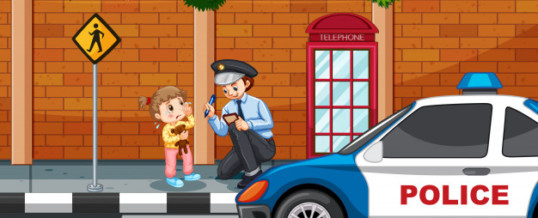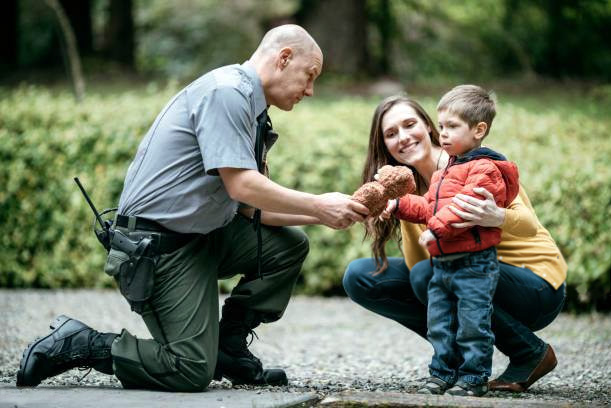
Individuals who have autism are seven times more likely to have interactions with police, which makes it all the more important to understand why some behaviors that may cause concern if exhibited by a neurotypical person could be misunderstood and may mean an individual with autism is overwhelmed or doesn’t fully understand what is expected in a situation.
Autism Prevalence is Rising Along with Incidents with Police
There are more than 2.1 million people in the United States who are diagnosed with autism, “a broad range of conditions characterized by challenges with social skills, repetitive behaviors, speech and nonverbal communication”.
Autism is a uniquely individual disorder that impacts each person differently because it operates on a spectrum. Some individuals with autism may have other co-occurring disorders, physical or mental cognitive impacts, along with common sensory needs or communication differences.
“My son is super high functioning but he struggles socially,” Kate Hooven, a mother of a son with autism, said. “It’s these kids and these types of adults who often become victims and end up in the system because they’re not understood. The system is just not currently prepared to handle them.”
It is estimated that one in 44 children will be diagnosed in the US and there is no sign of this number decreasing.
This begs the question, why aren’t all police officers required to be trained in autism?
Importance of Autism Training for Police Officers
Autism training for police officers allows the opportunity for officers to be able to recognize behaviors that might indicate autism more quickly and efficiently so that their interactions with their community can be safer and more effective.
On January 8, 2017, the Guardian found that 1 in 5 people killed by law enforcement in 2016 either had a mental health disability or were having a mental health crisis when they were killed. 3 in 10 jail inmates report having a cognitive disability. While there are numerous people in jail who already have a diagnosis, many people that are incarcerated are suspected to have autism but do not have a diagnosis.
Some people who have autism are incarcerated for things that they didn’t know that they did wrong, often due to their social challenges.
This can sometimes lead to a chain of incarcerations, often due to the challenges of not following rules properly when in jail or being easily manipulated.
 What is the Purpose of Autism Training?
What is the Purpose of Autism Training?
Chief Allen Muma, a police officer and trainer for almost 40 years, shares his take on the purpose of autism training.
Officer training helps inform officers in a number of areas, including:
- Overview of autism
- Why training is important
- How to recognize someone with ASD
- How to interact with someone with ASD
- How can I best manage risk in situations with someone with ASD
Learn more about autism training for law enforcement
Preventing Tragic Accidents
Requiring law enforcement to undergo autism training is so significant because it can prevent dangerous mistakes and misunderstandings.
Police officers are trained to read and interpret body language in order to determine the seriousness of a situation. However, someone with autism could actually exhibit very misleading body language, including something called “stimming”.
The purpose of autism training for police officers is more than just providing education or autism awareness. Training equips law enforcement with the tools they need to make necessary changes in behavior and operations.
“It’s not that we want police officers to be able to diagnose autism on the street. We want the light bulb to go off so that they can think, ‘Maybe this person has autism,’ and proceed accordingly,” said Danny Openden, president and CEO of Southwest Autism Research and Resource Center.
With autism diagnoses being incredibly high, it is far too common that an officer will encounter someone on the spectrum for this matter to be ignored.
“When you look at the numbers right now, we know that about one in every 54 people are somewhere on that spectrum. So it’s not a matter of if an officer is going to deal with somebody on the spectrum, it’s just a matter of when,” Lon Bartel, a retired Valley officer in Arizona, said.
The proper training also ensures that officers will have the ability to identify and handle the diverse range of characteristics and behaviors that come with the disorder.
“We’ve got people with autism with no communication whatsoever, and we’ve got people that are highly verbal but miss a lot of the social cues. And so a police officer might be talking to somebody who’s nonverbal and they’re not responding and that sounds or looks like noncompliance,” Openden said.
Openden also explains that a nonverbal individual might quickly reach into their pocket for a communication device, but to a police officer this could easily look like they are reaching for a gun. If the officer lacks knowledge and training, the end result could be fatal.
What Can Go Right With Training
When police officers possess knowledge and training in autism, the results are extraordinary. Many departments across the US, including those in Mesa, AZ, and St. Johns County, FL, are committing to ongoing training and certification to make sure they can serve this growing population.
Looking for the Signs
For example, a Norwood police officer, Brett Baker, attempted to stop a vehicle due to minor traffic violations. When the vehicle didn’t pull over, even with Baker’s flashing lights in the rearview, he continued to follow the car.
When the car pulled into a driveway and the driver got out, Baker immediately recognized signs of autism. He knew to approach the driver calmly due to his training and when the driver’s mother came outside they were all able to have a conversation.
The incident, that could have ended poorly, did not result in an arrest or a citation thanks to Baker’s understanding of autism.
Thinking Outside of the Box
Another example that highlights how important autism training is for police officers involves Corporal Christian Payamps, of Prince George’s County Police Department in Maryland.
Payamps was responding to a family dispute call that was made by a mother who was concerned with her 23-year-old son who has autism and bipolar disorder.
When Payamps arrived on scene he had to wait for the crisis team to get there. Upon waiting, he noted the musical instruments in the son’s room and mentioned that he is also a musician. The son, Kameron, picked up his guitar and Payamps followed by grabbing the bass. Together they played.
“He completely calmed down with the officer without any other intervention,” said Sharon Vollin, Kameron’s mother.
The training that Payamps received allowed him to remain calm and think outside of the box in order to connect with Kameron and ensure that he felt comfortable.
Communication Between Family Members and Law Enforcement
Having open communication between families with members on the spectrum and law enforcement can make a world of difference.
In South Orange, New Jersey, a young man wanders the streets in the middle of the night on a regular basis. Due to the fact that he often looks angry and doesn’t really communicate, this man could easily be mistaken as a potential criminal or threat.
However, things are not always what they seem.
The father’s communication with the police department ensured that all of the officers are aware of the man’s behavior and his disability. They have his name, his parent’s phone numbers, and details about his special needs.
“Police officers don’t want children to be afraid of us,” Sergeant Acevedo said. “In a tense situation, where we don’t know what to expect, we make split-second decisions. Knowing your child and having your child know us completely changes that situation.”
Autism Training Teaches Officers to Handle Wandering
Wandering and elopement are behaviors that are crucial for police officers to understand because they happen far too often with children who have autism. Effective autism training and certification addresses how to identify these behaviors, what to do about them, and how to safely return the child to their parents or caregivers.
“That child will have it in his head that he wants to go swimming or to the park,” says Wendy Fournier, president of the National Autism Association. “It’s what he wants to do regardless of the safety issues, which can be crossing a busy street without looking so he can get to his destination. It’s hard to stop him.”
Elopement is also a common behavior, but it looks more like bolting and usually occurs when the individual feels overwhelmed by their current environment.
Wandering Needs to be Taken Seriously
A four-year-old boy wandered from his home in Jacksonville, Florida, and ended up on Beach Boulevard, a busy highway. A police officer found him and was able to get him back to his home safely.
“Kids with autism can frequently get in danger or trouble and they don’t even know they’re in danger because their motor skills are so much better than their language or judgement,” said Dr. David Childers with UF Health.
In Newark, police found a young boy near a busy intersection. They believed the child was between six and nine years of age and realized that he had autism and was non-verbal. When they found the boy he wasn’t wearing clothes. To make matters worse, the mother of the boy did not even know he had been missing. He had simply wandered out of the house. The police were able to find the mother by posting a photo of the boy online asking the community to help locate the parents.
The Autism Population is Growing, Will We Be Ready?
As the number of children diagnosed with autism grows, law enforcement has to realize that these children will age into adults. Many will become independent members of society who will be able to drive, work, and interact in the world as all adults do.
Law enforcement needs to be prepared and know how to engage with this population in order to create positive outcomes and build healthy relationships with them.
It is time to take autism training and certification seriously and view it as an essential part of any police officer’s onboarding.
It’s no longer a matter of if a police officer will encounter an individual on the spectrum, it’s a matter of when. And when this happens, the officer must be prepared.
Learn more about autism training and certification for your department
Learn More About Law Enforcement Autism Training & Certification
JUL